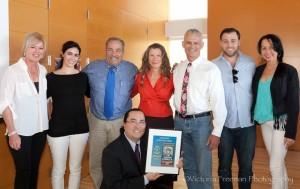
Commander Henry Stanley Jr.
By Theresa Jones
“A man does what he must in spite of personal consequences, in spite of obstacles and dangers and pressures and that is the basis of all human morality” was a quote from the eulogy of CDR Henry T. Stanley, Jr. who was killed in the line of duty, just five days shy of his 40th birthday on January 11, 1965. In a letter to Mary Ann Zimmermann Stanley, CDR Stanley’s widow, Captain James O’ Brien, then Commanding Officer of the USS Midway, spoke of how CDR Stanley’s “heroic action, his supreme sacrifice for his fellow man and his unswerving devotion to the higher values of life are the hallmarks of your very special kind of man.” A plaque located in a Mission San Jose park commemorates the bravery shown on that fateful day in 1965.
Henry T. Stanley Jr. was born on January 16, 1925 in Colon, U.S. Canal Zone, Panama to Janet and Capt. Henry T. Stanley Sr. who became Naval Aviator #186 in 1917. Capt. Stanley Sr. flew flying open-cockpit flying boats against German U-boats in WWI and was a Gray Eagle (awarded to the Naval Aviator on active duty the longest) and once commanded Ream Field Naval Auxiliary Air Station. As a Navy brat, CDR Stanley spent his childhood in Coronado, Alameda and Hawaii. Perhaps inspired by his own father, CDR Stanley earned his aviator wings though the Navy’s Aviation Cadet (NAVCAD) program in 1945. CDR Stanley flew mostly land based planes throughout his career to include the Stearman, TBM Avenger, PBY, PB4Y, P2V Neptune, and the WV2 Lockheed Constellation. His tours took him around the world to duty stations such as Adak, Alaska where he flew reconnaissance patrols along the Aleutian Chain; instructor duty in Corpus Christi, TX; flying for a utility squadron in Norfolk; as the assistant CIC officer of the USS Kearsarge in Coronado; department head duty flying WV-2s in Guam; as the head of of a test missile team that operated on the Pacific Missile test range in Pt. Mugu; and finally to Alameda, CA as the CIC Officer of the USS Midway (CVA-41).
CDR Stanley met his wife Mary Ann, a Navy nurse, while on Instructor Duty in Corpus Christi, TX. They were married in January of 1952 in the Chapel at Naval Air Station Norfolk. Their first child, Henry T. Stanley III was born the following year while they were stationed in Norfolk. After the Stanleys move to Coronado in 1955, their second son, William J. Stanley, was born while they lived on J Avenue near the First Street gate. Orders to Guam for a department head tour not only provided the excitement of living in a tropical paradise, but the birth of their third child, Barbara Ann, in 1959. CDR Stanley was a devoted husband and father where he mixed his love of family time with his other interests. He would play the piano at home for his loving wife after a day at work and made sure to send reel-to-reel taped audio letters to his family while deployed. He was caring of others and always made sure that Navy personnel who reported to him would have toys for their children at Christmas. His selflessness was exhibited most on that final day of his life.
While the Combat and Control Officer aboard the USS Midway, CDR Stanley would fly a minimum number of hours each month to accumulate flight pay hours as he was ship’s company and not part of a flying squadron. When time permitted, CDR Stanley and his assistant CIC Officer would go fly in the TV-2, a two-seat single engine jet. On January 11, 1965 CDR Henry T. Stanley Jr. and LCDR Harlan Fields were returning from flying out over the warning areas over the central valley in California when the engine flamed out in their TV-2 during their descent into NAS Alameda. Unable to restart the engine, CDR Stanley ordered LCDR Fields to eject at 5,000 feet as he remained with the now engineless and canopyless jet. He was concerned about leaving the jet over Fremont, a populated area below him. In order to prevent further tragedy, CDR Stanley elected to stay with the jet and navigate it to an empty field he spotted among a swath of suburban houses and schools. When he was sure the jet would not hit any homes, he ejected at a few hundred feet above the ground. The jet was so close to the houses that children playing nearby were splashed with mud, but there were no injuries on the ground. The ejection seat that CDR Stanley was strapped to malfunctioned and did not release him from the seat. He was killed when he, and the seat he was still strapped to, hit the ground. The following year and as a result of the crash investigation, the Navy spent $1,000,000 developing a fix for these ejection seats that potentially saved even more lives in the years to come.

After her husband was killed, Mary Ann moved her family back to her favorite place of all the places they had lived together, Coronado. The Stanley children consider both their mother and father heroes as they showed extreme courage in the face of such adversity. Because of his selfless and brave actions that day, CDR Henry T. Stanley Jr. was posthumously awarded the Distinguished Flying Cross for heroism in sacrificing his life to prevent many civilian deaths.
Visit more Hero Biographies: https://coronadotimes.com/?s=avenue+of+heroes




